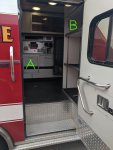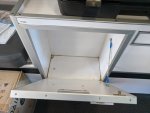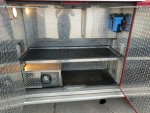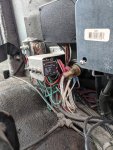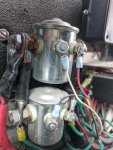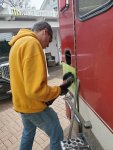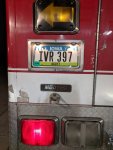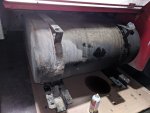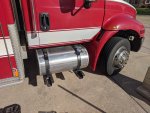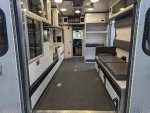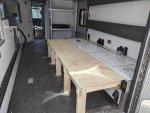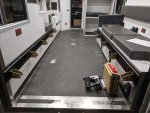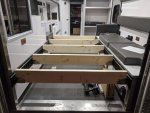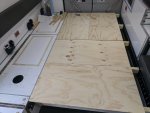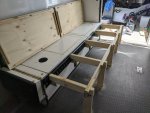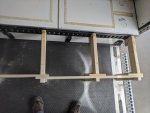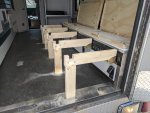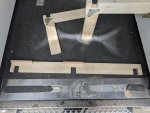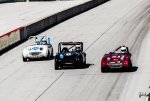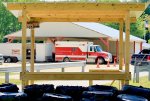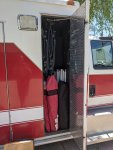qcdstick
Member
I finally pulled the trigger on a medium duty ambulance a month or so ago after years of mulling it over. Reason for going medium duty is I want to use it as a tow rig to pull a 28'-34' enclosed race trailer. My plans for it are pretty minimalist compared to a lot of the stuff on here, I only plan on minor modifications. I will add shore/generator power 110v Air Conditioning, some type of fridge/cooler, a microwave or cooktop, and a queen size bed. This (combined with the existing 110v shore power system) should be enough for me to register it as an RV and suit my wife and I's needs for weekends at the race track. The rest of the cabinets inside and out will likely be used as is and i don't see a good reason to need to change them. Plumbing / shower / toilet isn't a concern since those tend to be readily available at the track, no true off grid camping is planned. Might also use it as a tailgating rig during football season.
I've already gotten the graphics stripped. Some buffing of the paint will be required, I'm hoping to not have to re-paint (although the box is corroding in quite a few places) as I don't really mind the colors as is. Want to try and find a new end cap for the light bar, but otherwise things are in pretty good shape.
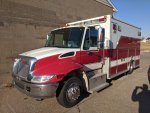
Specs:
2002 International 4300 LP
DT466 230hp / 620 ft lb
185k miles / 11,800 hours
Allison MD 3060 Trans
8k front / 12k rear
Air ride
Air Brakes
1000w Fleet Power Inverter / Charger (FP 1000-12)
LED interior lights in the module
Newish batteries, and newer tires all around (although as it turns out the fronts are out of round and I may replace them).
I bought it from the fire dept who ordered it new and they were able to provide a full maintenance history as well as all original the documentation and manuals. I have a digital 100+ page Medtec Part Manual, as well as a 267 page Electrical manual in PDF format I can make available if someone needs it. The department seemed to be still putting money in it (namely tires, batteries, and kingpins) through June of 2018. It went on reserve status with minimal use starting in November 2018 when the replacement unit went in service.
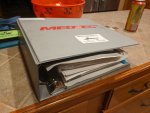
Has analog switch gear, and this relay panel seems great for troubleshooting. Everything is lableld with indicator lights on both the input and output side indicating if a given circuit is active. The big electrical manual seems to cover a newer digital system as well, thankfully they specified this one.
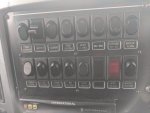
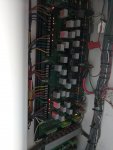
Walk through from cab to module

One of the things I really liked about this unit is that there is no rear cabinet on the passenger side so the squad bench is long enough for a queen sized mattress as is. I haven't seen many units configured this way, and I'm a tall dude so any unit with that rear cabinet would require it to be removed.
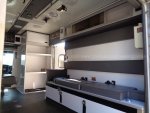
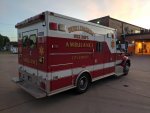
I've already gotten the graphics stripped. Some buffing of the paint will be required, I'm hoping to not have to re-paint (although the box is corroding in quite a few places) as I don't really mind the colors as is. Want to try and find a new end cap for the light bar, but otherwise things are in pretty good shape.

Specs:
2002 International 4300 LP
DT466 230hp / 620 ft lb
185k miles / 11,800 hours
Allison MD 3060 Trans
8k front / 12k rear
Air ride
Air Brakes
1000w Fleet Power Inverter / Charger (FP 1000-12)
LED interior lights in the module
Newish batteries, and newer tires all around (although as it turns out the fronts are out of round and I may replace them).
I bought it from the fire dept who ordered it new and they were able to provide a full maintenance history as well as all original the documentation and manuals. I have a digital 100+ page Medtec Part Manual, as well as a 267 page Electrical manual in PDF format I can make available if someone needs it. The department seemed to be still putting money in it (namely tires, batteries, and kingpins) through June of 2018. It went on reserve status with minimal use starting in November 2018 when the replacement unit went in service.

Has analog switch gear, and this relay panel seems great for troubleshooting. Everything is lableld with indicator lights on both the input and output side indicating if a given circuit is active. The big electrical manual seems to cover a newer digital system as well, thankfully they specified this one.


Walk through from cab to module

One of the things I really liked about this unit is that there is no rear cabinet on the passenger side so the squad bench is long enough for a queen sized mattress as is. I haven't seen many units configured this way, and I'm a tall dude so any unit with that rear cabinet would require it to be removed.


Last edited:

